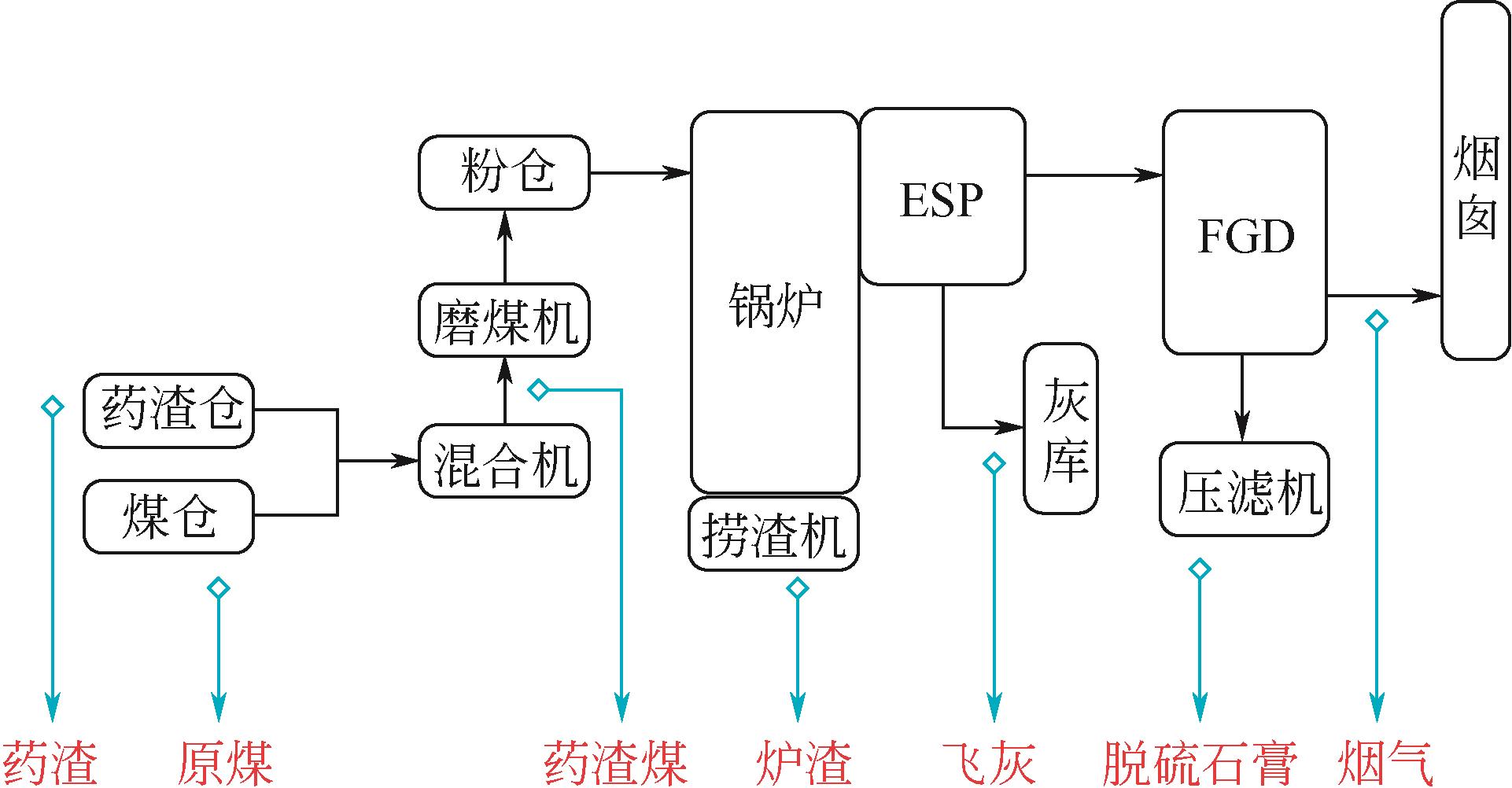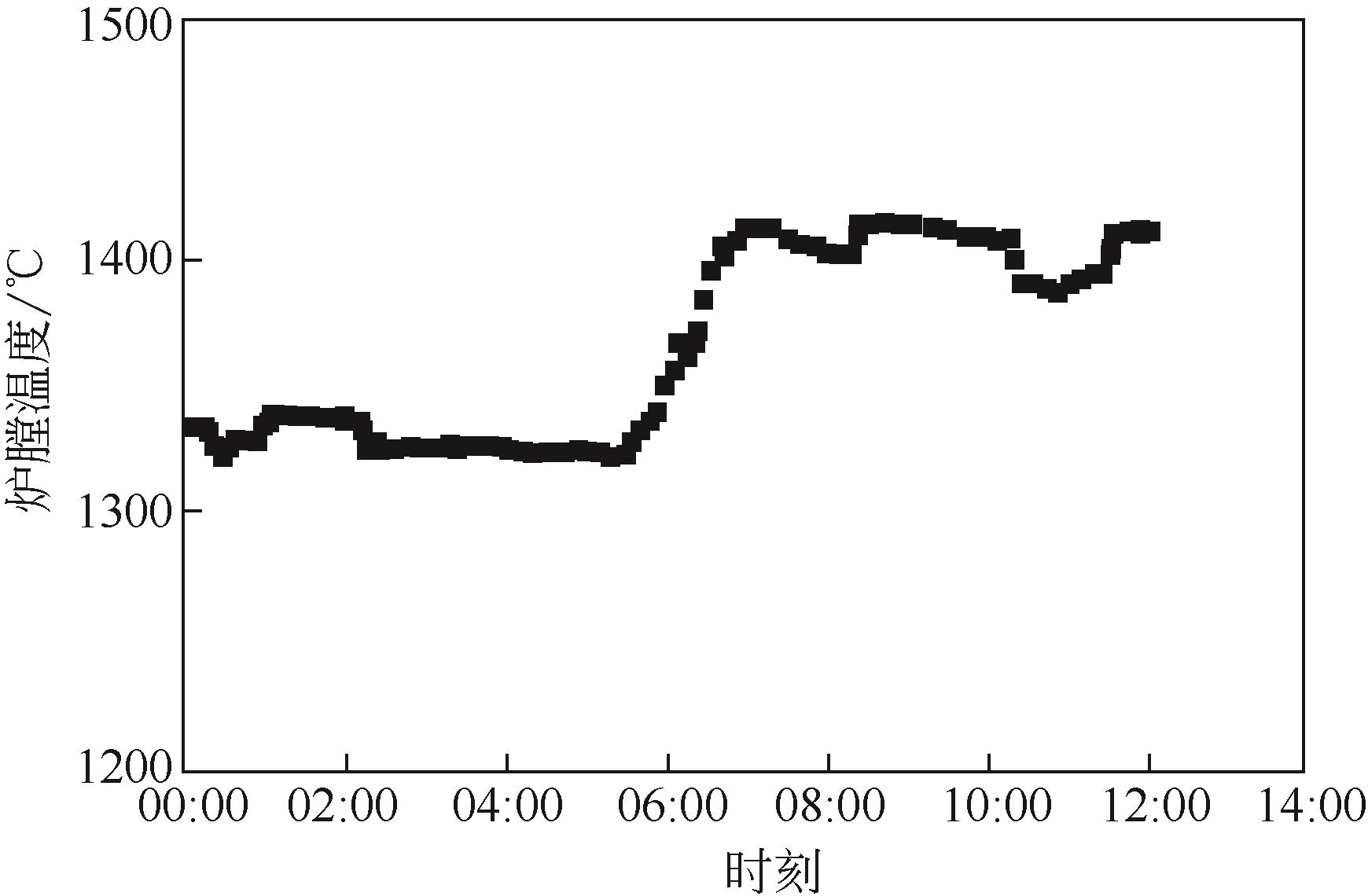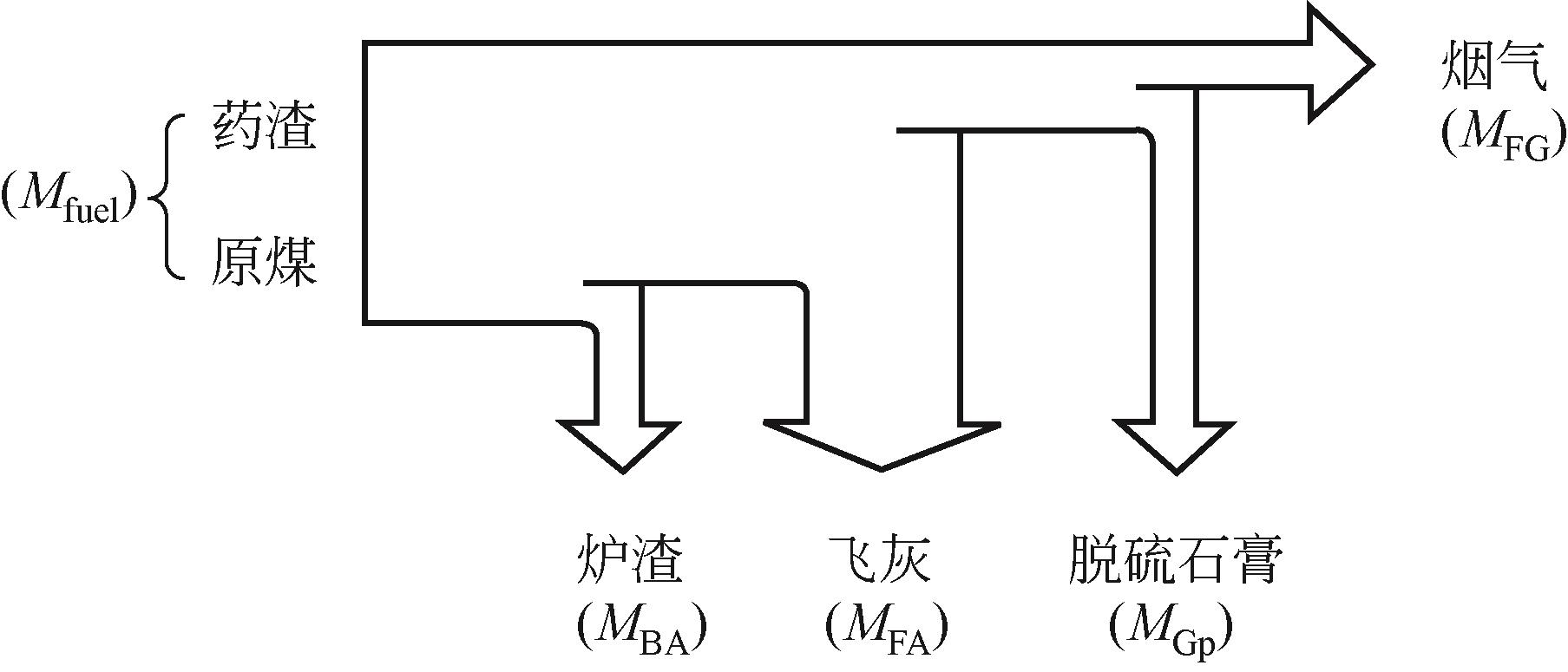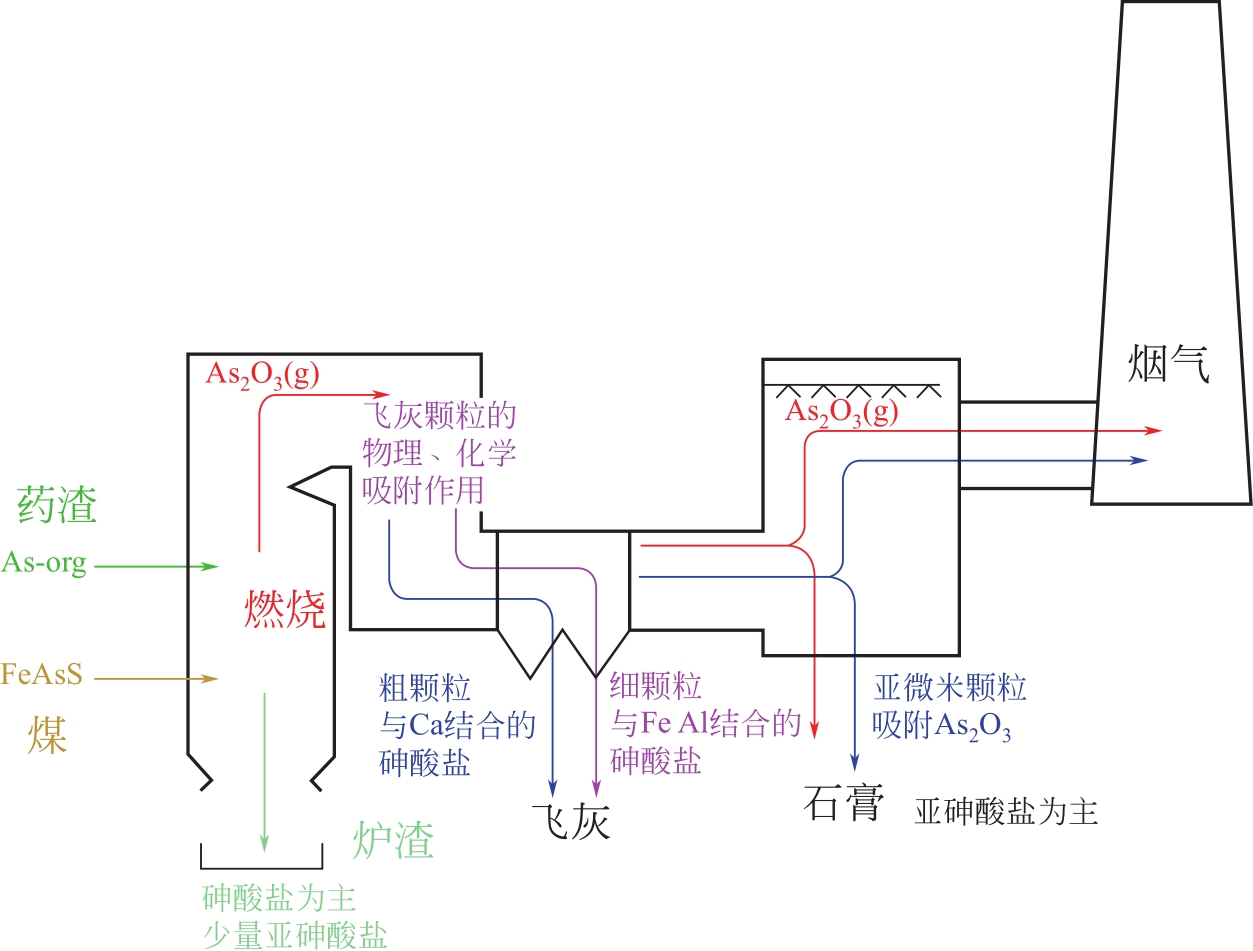化工进展 ›› 2021, Vol. 40 ›› Issue (12): 6916-6924.DOI: 10.16085/j.issn.1000-6613.54-化工进展2021-0033
煤粉炉协同共处理抗生素药渣Cr、As的迁移特性
肖海平1( ), 李昕耀1(
), 李昕耀1( ), 蒋炎飞1, 闫大海2, 刘忠1
), 蒋炎飞1, 闫大海2, 刘忠1
- 1.华北电力大学能源动力与机械工程学院,北京 102206
2.中国环境科学研究院固体废物污染控制技术研究所,北京 100012
-
收稿日期:2021-01-07修回日期:2021-04-03出版日期:2021-12-05发布日期:2021-12-21 -
通讯作者:李昕耀 -
作者简介:肖海平(1978—),男,博士,副教授,研究方向为燃煤污染物排放机理与控制。E-mail:dr_xiaohaiping@126.com 。 -
基金资助:国家自然科学基金(51676070)
Migration characteristics of chromium and arsenic during co-processing of antibiotic residue in a pulverized coal fired boiler
XIAO Haiping1( ), LI Xinyao1(
), LI Xinyao1( ), JIANG Yanfei1, YAN Dahai2, LIU Zhong1
), JIANG Yanfei1, YAN Dahai2, LIU Zhong1
- 1.Energy Power and Mechanical Engineering Department, North China Electric Power University, Beijing 102206, China
2.Research Institute of Solid Waste Management, Chinese Research Academy of Environmental Sciences, Beijing 100012, China
-
Received:2021-01-07Revised:2021-04-03Online:2021-12-05Published:2021-12-21 -
Contact:LI Xinyao
摘要:
利用某300MW煤粉锅炉进行了协同处理抗生素药渣试验,研究了掺烧期间Cr、As元素的迁移特性及对环境的影响。收集样品并用电感耦合等离子质谱法分析重金属含量,以9.09%比例掺烧药渣,入炉Cr和As分别增加至1.46倍和1.44倍。Cr和As元素的质量平衡系数分别为88.3%~96.2%和75.8%~76.5%。协同工况下,有92.73% Cr富集在飞灰中,烟气Cr全部为颗粒态,占0.13%;As在飞灰的分布低于Cr,有49.83%被飞灰吸附,烟气脱硫系统能够捕获从电除尘逃逸的As,24.64%的入炉As被固定于脱硫石膏中,有0.008%随烟气排放,烟气As有87.2%为颗粒态,12.8%为气态形式。烟气中的Cr和As浓度达到排放标准,固体产物的Cr、As浸出浓度均低于危废鉴定标准限值,利用煤粉炉协同处置抗生素药渣工艺是安全可行的。
中图分类号:
引用本文
肖海平, 李昕耀, 蒋炎飞, 闫大海, 刘忠. 煤粉炉协同共处理抗生素药渣Cr、As的迁移特性[J]. 化工进展, 2021, 40(12): 6916-6924.
XIAO Haiping, LI Xinyao, JIANG Yanfei, YAN Dahai, LIU Zhong. Migration characteristics of chromium and arsenic during co-processing of antibiotic residue in a pulverized coal fired boiler[J]. Chemical Industry and Engineering Progress, 2021, 40(12): 6916-6924.
| 项目 | 药渣 | 原煤 | 药渣煤 |
|---|---|---|---|
| 水分Mar/% | 8.4 | 12.2 | 11.85 |
| 灰分Aar/% | 14.16 | 28.97 | 27.62 |
| 挥发分Var/% | 65.6 | 18.88 | 23.13 |
| 固定碳FCar/% | 11.84 | 39.95 | 37.40 |
| 发热量Qnet.ar/MJ·kg-1 | 15.69 | 17.738 | 17.55 |
表1 燃料的工业分析
| 项目 | 药渣 | 原煤 | 药渣煤 |
|---|---|---|---|
| 水分Mar/% | 8.4 | 12.2 | 11.85 |
| 灰分Aar/% | 14.16 | 28.97 | 27.62 |
| 挥发分Var/% | 65.6 | 18.88 | 23.13 |
| 固定碳FCar/% | 11.84 | 39.95 | 37.40 |
| 发热量Qnet.ar/MJ·kg-1 | 15.69 | 17.738 | 17.55 |
| 原料 | 汞 | 镉 | 铅 | 砷 | 铬 | 铜 | 镍 | 锡 | 锑 | 锰 |
|---|---|---|---|---|---|---|---|---|---|---|
| 药渣 | 0.048 | 0.18 | 7.0 | 146.52 | 200.2 | 7.64 | 6.25 | 1.03 | 0.67 | 97.5 |
| 原煤 | 0.0734 | 0.287 | 7.188 | 23.21 | 34.54 | 6.73 | 8.013 | 2.136 | 0.3754 | 105.77 |
表2 药渣与原煤的重金属浓度 (mg/kg)
| 原料 | 汞 | 镉 | 铅 | 砷 | 铬 | 铜 | 镍 | 锡 | 锑 | 锰 |
|---|---|---|---|---|---|---|---|---|---|---|
| 药渣 | 0.048 | 0.18 | 7.0 | 146.52 | 200.2 | 7.64 | 6.25 | 1.03 | 0.67 | 97.5 |
| 原煤 | 0.0734 | 0.287 | 7.188 | 23.21 | 34.54 | 6.73 | 8.013 | 2.136 | 0.3754 | 105.77 |
| 工况 | 输入项/t·h-1 | 输出项 | ||||
|---|---|---|---|---|---|---|
| 药渣 | 原煤 | 炉渣 | 飞灰 /t·h-1 | 脱硫石膏 /t·h-1 | 烟气实测流量 /m3·h-1 | |
| 协同 | 10.16 | 101.62 | 2.25 | 20.28 | 9.8 | 7.92×105 |
| 空白 | — | 109.69 | 2.28 | 20.55 | 10.2 | 7.95×105 |
表3 机组系统物料进出统计
| 工况 | 输入项/t·h-1 | 输出项 | ||||
|---|---|---|---|---|---|---|
| 药渣 | 原煤 | 炉渣 | 飞灰 /t·h-1 | 脱硫石膏 /t·h-1 | 烟气实测流量 /m3·h-1 | |
| 协同 | 10.16 | 101.62 | 2.25 | 20.28 | 9.8 | 7.92×105 |
| 空白 | — | 109.69 | 2.28 | 20.55 | 10.2 | 7.95×105 |
| 工况 | 输入项/% | 输出项/% | ||||
|---|---|---|---|---|---|---|
| 原煤 | 药渣 | 炉渣 | 飞灰 | 石膏 | 烟气 | |
| 协同 | 63.3 | 36.7 | 1.28 | 92.73 | 2.00 | 0.13 |
| 空白 | 100 | — | 2.01 | 83.79 | 2.14 | 0.18 |
表5 Cr元素的相对分布
| 工况 | 输入项/% | 输出项/% | ||||
|---|---|---|---|---|---|---|
| 原煤 | 药渣 | 炉渣 | 飞灰 | 石膏 | 烟气 | |
| 协同 | 63.3 | 36.7 | 1.28 | 92.73 | 2.00 | 0.13 |
| 空白 | 100 | — | 2.01 | 83.79 | 2.14 | 0.18 |
| 工况 | 输入项/% | 输出项/% | ||||
|---|---|---|---|---|---|---|
| 原煤 | 药渣 | 炉渣 | 飞灰 | 石膏 | 烟气 | |
| 协同 | 61.3 | 38.7 | 1.32 | 49.83 | 24.64 | 0.011 |
| 空白 | 100 | — | 1.42 | 50.65 | 24.42 | 0.008 |
表6 As元素的相对分布
| 工况 | 输入项/% | 输出项/% | ||||
|---|---|---|---|---|---|---|
| 原煤 | 药渣 | 炉渣 | 飞灰 | 石膏 | 烟气 | |
| 协同 | 61.3 | 38.7 | 1.32 | 49.83 | 24.64 | 0.011 |
| 空白 | 100 | — | 1.42 | 50.65 | 24.42 | 0.008 |
| 元素 | 工况 | 烟气浓度/μg·m-3 | 发电排放量 /×10-3lb·GWh-1 | ||
|---|---|---|---|---|---|
| 颗粒态 | 气态 | 总浓度 | |||
| Cr | 空白 | 0.75 | — | 0.75 | 5.36 |
| 协同 | 0.89 | — | 0.89 | 6.43 | |
| As | 空白 | 0.35 | 0.011 | 0.361 | 2.58 |
| 协同 | 0.34 | 0.05 | 0.39 | 2.82 | |
表7 烟气Cr与As元素的排放
| 元素 | 工况 | 烟气浓度/μg·m-3 | 发电排放量 /×10-3lb·GWh-1 | ||
|---|---|---|---|---|---|
| 颗粒态 | 气态 | 总浓度 | |||
| Cr | 空白 | 0.75 | — | 0.75 | 5.36 |
| 协同 | 0.89 | — | 0.89 | 6.43 | |
| As | 空白 | 0.35 | 0.011 | 0.361 | 2.58 |
| 协同 | 0.34 | 0.05 | 0.39 | 2.82 | |
| 项目 | 炉渣 | 飞灰 | 石膏 | |||||
|---|---|---|---|---|---|---|---|---|
| 协同 | 空白 | 协同 | 空白 | 协同 | 空白 | |||
| Cr浓度/mg?L-1 | 0.413 | 0.065 | 0.568 | 0.113 | 0.002 | 0.003 | ||
| As浓度/mg?L-1 | 0.0142 | 0.0036 | 0.0109 | 0.0113 | 0.0081 | 0.0069 | ||
表 8 固体样本Cr与As的浸出浓度
| 项目 | 炉渣 | 飞灰 | 石膏 | |||||
|---|---|---|---|---|---|---|---|---|
| 协同 | 空白 | 协同 | 空白 | 协同 | 空白 | |||
| Cr浓度/mg?L-1 | 0.413 | 0.065 | 0.568 | 0.113 | 0.002 | 0.003 | ||
| As浓度/mg?L-1 | 0.0142 | 0.0036 | 0.0109 | 0.0113 | 0.0081 | 0.0069 | ||
| 12 | Ministry of Environmental Protection of the People’s Republic of China. Environmental protection standard of the People’s Republic of China: solid waste-determination of metals-inductively coupled plasma mass spectrometry (ICP-MS). [S]. Beijing: China Environment Science Press, 2015. |
| 13 | 国家环境保护总局. 中华人民共和国推荐性国家标准: 固定污染源排气中颗粒物测定与气态污染物采样方法[S]. 1996. |
| State Environmental Protection Administration of the People’s Republic of China. National standard (recommended) of the People’s Republic of China: the determination of particulates and sampling methods of gaseous pollutants emitted from exhaust gas of stationary source. [S]. 1996. | |
| 14 | 中华人民共和国环境保护部. 中华人民共和国环保行业标准: 空气和废气 颗粒物中铅等金属元素的测定 电感耦合等离子体质谱法[S]. 北京: 中国环境科学出版社, 2013. |
| Ministry of Environmental Protection of the People’s Republic of China. Environmental protection standard of the People’s Republic of China: ambient air and stationary source emission - Determination of metals in ambient particulate matter-inductively coupled plasma/mass spectrometry (ICP-MS). [S]. Beijing: China Environment Science Press, 2013. | |
| 15 | 国家环境保护总局. 中华人民共和国环保行业标准: 固体废物 浸出毒性浸出方法 硫酸硝酸法[S]. 北京: 中国环境科学出版社, 2007. |
| State Environmental Protection Administration of the People’s Republic of China. Environmental protection standard of the People’s Republic of China: solid waste-extraction procedure for leaching toxicity-sulphuric acid & nitric acid method. [S]. Beijing: China Environment Science Press, 2007. | |
| 16 | XU M H, YAN R, ZHENG C G, et al. Status of trace element emission in a coal combustion process: a review[J]. Fuel Processing Technology, 2004, 85(2/3): 215-237. |
| 1 | 中华人民共和国生态环境部. 2019年全国大、中城市固体废物污染环境防治年报[R].北京.2019. |
| Ministry of Ecology and Environment of the People’s Republic of China. 2019 National annual report on the prevention and control of solid waste pollution in large and medium cities[R]. Beijing. MEE. 2019. | |
| 17 | HUANG Y J, JIN B S, ZHONG Z P, et al. Trace elements (Mn, Cr, Pb, Se, Zn, Cd and Hg) in emissions from a pulverized coal boiler[J]. Fuel Processing Technology, 2004, 86(1): 23-32. |
| 18 | 李立园, 汤泉, 郑刘根, 等. 不同燃烧温度下煤中铬迁移和释放特性[J]. 环境化学, 2018, 37(3): 437-444. |
| 2 | 中华人民共和国生态环境部. 国家危险废物名录[EB/OL]. 2020.. |
| Ministry of Ecology and Environment of the People’s Republic of China. National hazardous waste list[EB/OL]. 2020. . | |
| 18 | LI Liyuan, TANG Quan, ZHENG Liugen, et al. Migration and volatilization of chromium in coal under different combustion temperatures[J]. Environmental Chemistry, 2018, 37(3): 437-444. |
| 19 | GALBREATH K C, ZYGARLICKE C J. Formation and chemical speciation of arsenic-, chromium-, and nickel-bearing coal combustion PM2.5[J]. Fuel Processing Technology, 2004, 85(6/7): 701-726. |
| 20 | GOODARZI F, HUGGINS F E. Speciation of chromium in feed coals and ash byproducts from Canadian power plants burning subbituminous and bituminous coals[J]. Energy & Fuels, 2005, 19(6): 2500-2508. |
| 21 | STAM A F. Chromium speciation in coal and biomass co-combustion products[J]. Environmental Science & Technology, 2011, 45(6): 2450-2456 |
| 22 | KAVOURAS P, PANTAZOPOULOU E, VARITIS S, et al. Incineration of tannery sludge under oxic and anoxic conditions: study of chromium speciation[J]. Journal of Hazardous Materials, 2015, 283: 672-679. |
| 23 | ZHANG Y S, SHANG P F, WANG J W, et al. Trace element (Hg, As, Cr, Cd, Pb) distribution and speciation in coal-fired power plants[J]. Fuel, 2017, 208: 647-654. |
| 24 | LIU H M, WANG C B, ZOU C, et al. Simultaneous volatilization characteristics of arsenic and sulfur during isothermal coal combustion[J]. Fuel, 2017, 203: 152-161. |
| 25 | SHEN F, LIU J, ZHANG Z, et al. On-line analysis and kinetic behavior of arsenic release during coal combustion and pyrolysis[J]. Environmental Science & Technology, 2015,49(22): 13716-13723. |
| 26 | JADHAV R A, FAN L S. Capture of gas-phase arsenic oxide by lime: kinetic and mechanistic studies[J]. Environmental Science & Technology, 2001, 35(4): 794-799. |
| 27 | ZHAO S L, DUAN Y F, CHEN C, et al. Distribution and speciation transformation of hazardous trace element arsenic in particulate matter of a coal-fired power plant[J]. Energy & Fuels, 2018, 32(5): 6049-6055. |
| 28 | SHAH P, STREZOV V, STEVANOV C, et al. Speciation of Arsenic and selenium in coal combustion products[J]. Energy & Fuels, 2007,21(2): 506-512. |
| 29 | GONG H Y, HUANG Y D, HU H Y, et al. Insight of particulate arsenic removal from coal-fired power plants[J]. Fuel, 2019, 257: 116018. |
| 30 | MARCZAK M, WIEROŃSKA F, BURMISTRZ P, et al. Investigation of subbituminous coal and lignite combustion processes in terms of mercury and arsenic removal[J]. Fuel, 2019, 251: 572-579. |
| 31 | SWANSON S M, ENGLE M A, RUPPERT L F, et al. Partitioning of selected trace elements in coal combustion products from two coal-burning power plants in the United States[J]. International Journal of Coal Geology, 2013, 113: 116-126. |
| 32 | LIU Z X, HAO Y, ZHANG J, et al. The characteristics of arsenic in Chinese coal-fired power plant flue gas desulphurisation gypsum[J]. Fuel, 2020, 271: 117515. |
| 33 | JIA C Y, WU L C, CHEN Q S, et al. Distribution behavior of arsenate into α-calcium sulfate hemihydrate transformed from gypsum in solution[J]. Chemosphere, 2020, 255: 126936. |
| 34 | FERNÁNDEZ-MARTÍNEZ A, ROMÁN-ROSS G, CUELLO G J, et al. Arsenic uptake by gypsum and calcite: modelling and probing by neutron and X-ray scattering[J]. Physica B: Condensed Matter, 2006, 385/386: 935-937. |
| 35 | WANG C B, LIU H M, ZHANG Y, et al. Review of arsenic behavior during coal combustion: volatilization, transformation, emission and removal technologies[J]. Progress in Energy and Combustion Science, 2018, 68: 1-28. |
| 36 | HUANG Y D, GONG H Y, HU H Y, et al. Migration and emission behavior of arsenic and selenium in a circulating fluidized bed power plant burning arsenic/selenium-enriched coal[J]. Chemosphere, 2021, 263: 127920. |
| 37 | United States Environmental Protection Agency. National emission standards for hazardous air pollutants from coal-and oil-fired electric utility steam generating units and standards of performance for fossil-fuel-fired electric utility, industrial-commercial-institutional, and small industrial-commercial-institutional steam generating units; technical correction: EPA-H; FRL-9942-28-OAR[S]. 2016. |
| 3 | 李阳. 链霉素药渣危害因子确证及其诱导细菌耐药机制研究[D]. 北京: 中国农业科学院, 2017. |
| LI Yang. Study on hazard factors confirmation of streptomycin dregs and resistance mechanisms induced by the factors in bacteria[D]. Beijing: Chinese Academy of Agricultural Sciences, 2017. | |
| 4 | 张维娇. 泰乐菌素降解菌的筛选及药渣无害化处理方法的研究[D]. 济南: 齐鲁工业大学, 2018. |
| ZHANG Weijiao. Screening of tylosin degrading bacteria and harmless treatment of drug residues[D]. Jinan: Qilu University of Technology, 2018. | |
| 5 | 魏永久, 张月, 郭雨生, 等. 喷淋鼓泡塔内氨水对烟气中As2O3的吸收特性[J]. 化工进展, 2020, 39(3): 834-841. |
| WEI Yongjiu, ZHANG Yue, GUO Yusheng, et al. Absorption characteristics of As2O3 from flue gas by ammonia in spray-and-bubble column[J]. Chemical Industry and Engineering Progress, 2020, 39(3): 834-841. | |
| 6 | CHEN J J, SUN Y Q, ZHANG Z T. Evolution of trace elements and polluting gases toward clean co-combustion of coal and sewage sludge[J]. Fuel, 2020, 280: 118685. |
| 7 | 张宗振, 李德波, 冯永新, 等. 1000 MW燃煤锅炉污泥掺烧试验研究与工程应用[J]. 热能动力工程, 2020, 35(1): 210-216. |
| ZHANG Zongzhen, LI Debo, FENG Yongxin, et al. Investigation and applications of co-combustion of sludge in a 1000 MW coal fired boiler[J]. Journal of Engineering for Thermal Energy and Power, 2020, 35(1): 210-216. | |
| 8 | DONG H, JIANG X G, LYU G, et al. Co-combustion of tannery sludge in a commercial circulating fluidized bed boiler[J]. Waste Management, 2015, 46: 227-233. |
| 9 | 王斌, 董玉平, 毛叶兵, 等. 抗生素菌渣的流化床快速热解特性[J]. 化工进展, 2017, 36(3): 1113-1119. |
| WANG Bin, DONG Yuping, MAO Yebing, et al. Fast pyrolysis behavior of fungus residues in a fluidized bed reactor[J]. Chemical Industry and Engineering Progress, 2017, 36(3): 1113-1119. | |
| 10 | 张伟, 陈晓平, 王清, 等. 城市污泥流化床中低温空气气化及重金属迁移特性[J]. 化工进展, 2019, 38(4): 2011-2021. |
| ZHANG Wei, CHEN Xiaoping, WANG Qing, et al. Characteristics of sewage sludge medium-low temperature gasification and heavy metal migration in a fluidized bed reactor[J]. Chemical Industry and Engineering Progress, 2019, 38(4): 2011-2021. | |
| 11 | ZHUANG X Z, SONG Y P, ZHAN H, et al. Synergistic effects on the co-combustion of medicinal biowastes with coals of different ranks[J]. Renewable Energy, 2019, 140: 380-389. |
| 12 | 中华人民共和国环境保护部. 中华人民共和国环保行业标准: 固体废物 金属元素的测定 电感耦合等离子体质谱法[S]. 北京: 中国环境科学出版社, 2015. |
| [1] | 李世霖, 胡景泽, 王毅霖, 王庆吉, 邵磊. 电渗析分离提取高值组分的研究进展[J]. 化工进展, 2023, 42(S1): 420-429. |
| [2] | 王莹, 韩云平, 李琳, 李衍博, 李慧丽, 颜昌仁, 李彩侠. 城市污水厂病毒气溶胶逸散特征研究现状与未来展望[J]. 化工进展, 2023, 42(S1): 439-446. |
| [3] | 许春树, 姚庆达, 梁永贤, 周华龙. 共价有机框架材料功能化策略及其对Hg(Ⅱ)和Cr(Ⅵ)的吸附性能研究进展[J]. 化工进展, 2023, 42(S1): 461-478. |
| [4] | 李宁, 李金科, 董金善. 乙烯裂解炉多孔介质燃烧器的研究与开发[J]. 化工进展, 2023, 42(S1): 73-83. |
| [5] | 邵博识, 谭宏博. 锯齿波纹板对挥发性有机物低温脱除过程强化模拟分析[J]. 化工进展, 2023, 42(S1): 84-93. |
| [6] | 赖诗妮, 江丽霞, 李军, 黄宏宇, 小林敬幸. 含碳掺氨燃料的研究进展[J]. 化工进展, 2023, 42(9): 4603-4615. |
| [7] | 葛全倩, 徐迈, 梁铣, 王凤武. MOFs材料在光电催化领域应用的研究进展[J]. 化工进展, 2023, 42(9): 4692-4705. |
| [8] | 李卫华, 于倩雯, 尹俊权, 吴寅凯, 孙英杰, 王琰, 王华伟, 杨玉飞, 龙於洋, 黄启飞, 葛燕辰, 何依洋, 赵灵燕. 酸雨环境下填埋飞灰吨袋破损后重金属的溶出行为[J]. 化工进展, 2023, 42(9): 4917-4928. |
| [9] | 李志远, 黄亚继, 赵佳琪, 于梦竹, 朱志成, 程好强, 时浩, 王圣. 污泥与聚氯乙烯共热解重金属特性[J]. 化工进展, 2023, 42(9): 4947-4956. |
| [10] | 杨静, 李博, 李文军, 刘晓娜, 汤刘元, 刘月, 钱天伟. 焦化污染场地中萘降解菌的分离及降解特性[J]. 化工进展, 2023, 42(8): 4351-4361. |
| [11] | 徐杰, 夏隆博, 罗平, 邹栋, 仲兆祥. 面向膜蒸馏过程的全疏膜制备及其应用进展[J]. 化工进展, 2023, 42(8): 3943-3955. |
| [12] | 徐伟, 李凯军, 宋林烨, 张兴惠, 姚舜华. 光催化及其协同电化学降解VOCs的研究进展[J]. 化工进展, 2023, 42(7): 3520-3531. |
| [13] | 张杉, 仲兆平, 杨宇轩, 杜浩然, 李骞. 磷酸盐改性高岭土对生活垃圾热解过程中重金属的富集[J]. 化工进展, 2023, 42(7): 3893-3903. |
| [14] | 郑昕, 贾里, 王彦霖, 张靖超, 陈世虎, 乔晓磊, 樊保国. 污泥与煤泥混烧对重金属固留特性的影响[J]. 化工进展, 2023, 42(6): 3233-3241. |
| [15] | 修浩然, 王云刚, 白彦渊, 邹立, 刘阳. 准东煤/市政污泥混燃燃烧特性及灰熔融行为分析[J]. 化工进展, 2023, 42(6): 3242-3252. |
| 阅读次数 | ||||||
|
全文 |
|
|||||
|
摘要 |
|
|||||






